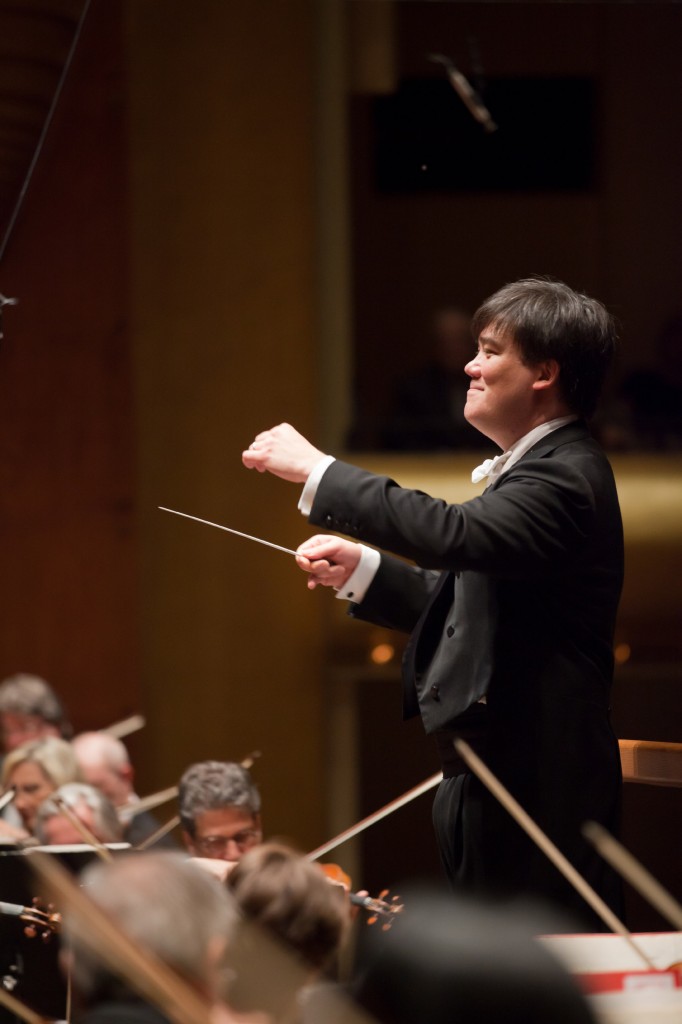Gilbert, Philharmonic at their finest in Carl Nielsen

Alan Gilbert conducted the New York Philharmonic in an all-Nielsen program Wednesday night. File photo: Chris Lee
Two-thirds through its Carl Nielsen Project, which will present and record the composer’s six symphonies and three concertos, the New York Philharmonic entered the final stretch on Wednesday night. If either orchestra or conductor has any fatigue in running through Nielsen’s catalogue, it didn’t show. With a program featuring Symphonies No. 5 and No. 6, as well as the Maskarade Overture, they completed the cycle of the composer’s symphonies, and set out to show a more playful side of the prickly Danish composer. While his work is often “troubling and bleak,” Gilbert admitted, “Nielsen can be a romp and a good time.”
As if to prove his hypothesis on the fun-loving Nielsen, Gilbert led off with an exuberant dash through the Maskarade Overture, which prefaced the composer’s only comedic opera. Setting a furious pace, the musicians skipped through waltzes and romantic themes that the composer plucked from subsequent acts. The first few bars were a bit muddled under such an aggressive tempo, but Gilbert quickly reigned in the without sacrificing energy.
However, the Symphony No. 5, which followed, falls in the former category of darker and thornier works, and one that the Philharmonic famously recorded under Leonard Bernstein in 1962. Written just after the end of World War I, it conveys an allegory of the fight between good and evil within two long movements.
The momentum from the overture carried into the ominous opening of the first movement, a tremolo of nervous energy coursing through the string section. This is abruptly interrupted by a snare drum that Nielsen instructs to wreak havoc upon the rest of the orchestra.
Gilbert set principal percussionist Christopher Lamb on the rest of the Philharmonic, and he relentlessly staged an attack with a variety of dynamics. Sounding at once like a drum major and a rain of bullets, the drumming kept the piece spontaneous and troubling. In a clever bit of stagecraft, Lamb, receded off stage, as Anthony McGill, the orchestra’s new principal clarinet (who will play the solo part of Nielsen’s Clarinet Concerto to finish the cycle this January), played a wistful idyll to close the movement.
The tension continued through the second movement with a series of roiling tempests, relentlessly pounding timpani, repetitive motifs, and a heroic effort by the horn section. The orchestra was on edge throughout, though its final note seemed more of a sigh of relief than a swelling triumphal chord.
Symphony No. 6, deceptively subtitled “Sinfonia Semplice,” received its belated Philharmonic premiere. The most abstract of the evening’s offerings, Nielsen wrote it while he was in ill-health and contemplating death, yet he considered it his most “idyllic” in character.
At first orchestra chimes seem to mark off seconds, and then eerie violins break into Hitchockian slashing sounds. But Gilbert delighted in marking a number of well-placed gags. The second movement, “Humoreske,” is a sparingly orchestrated and pointillist patchwork of blurts in brass and squiggly runs in the reeds that Gilbert drew out in curlicues with his baton.
After a third movement that seems to straddle the lines between the elegant and grotesque, the final section contains a theme and variation section. Gilbert whipped the full orchestra into a surging climax, only to be undercut by two bassoons blurting out B-flat. The conductor described it as a “raspberry” from Nielsen, and it was a moment of levity in after an exploration of the human condition.
This program will be repeated 7:30 p.m. Thursday and 2 p.m. Friday. nyphil.org